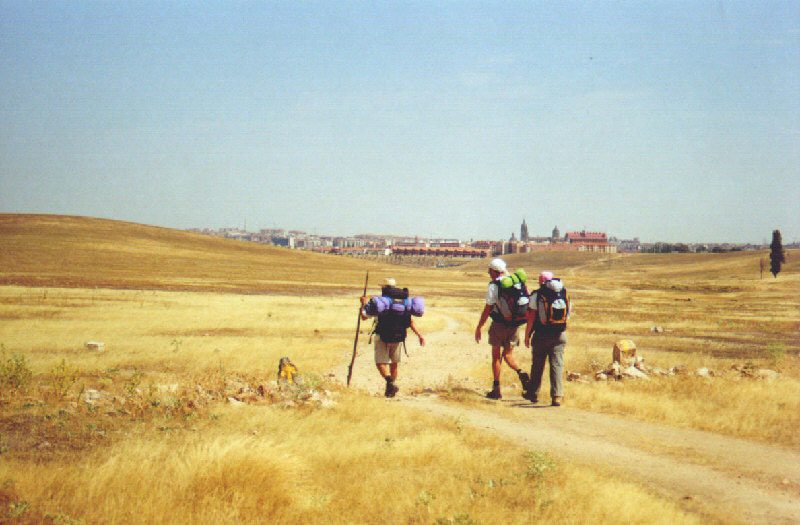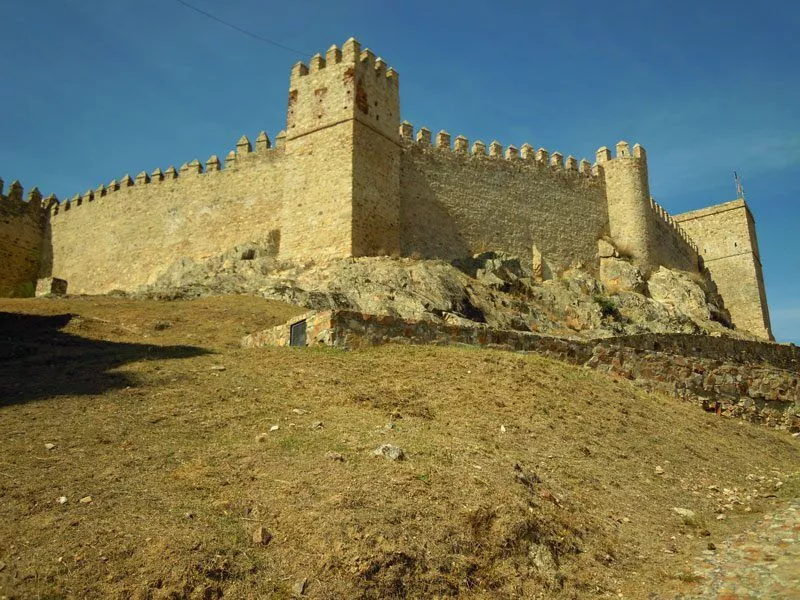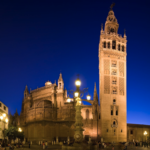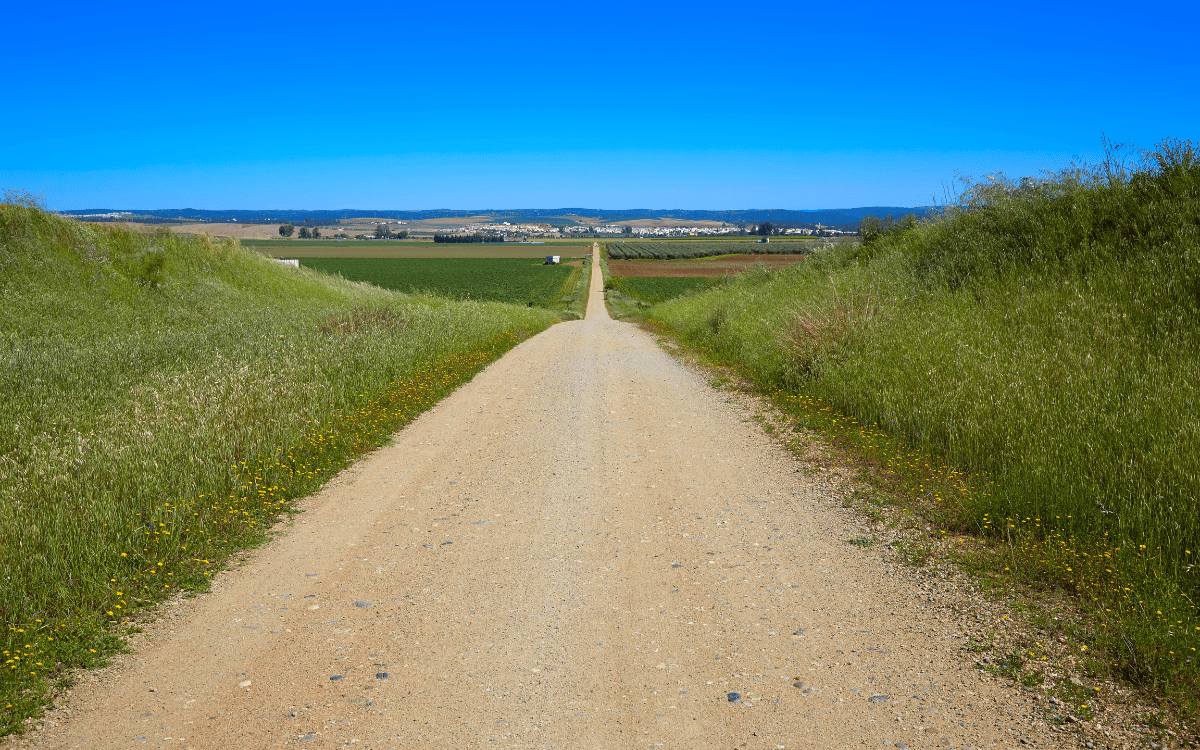The longest of the Camino pilgrimages, the Via de la Plata, starts in the south of Spain at Seville. It is also known as Ruta de la Plata or Camino Mozárabe (The Mozarabic Route).
This route owes its existence to a set of Roman roads that linked the southwest with the northwest coast through two major settlements: Emerita Augusta (Mérida) and Asturica Augusta (Astorga). A few centuries later, Arabs used the stone-paved roads to advance their conquest of the peninsular territories. However, once the Spanish re-conquered their land, the road became a safe passage for many Christian devotees who marched tirelessly to visit the tomb of Santiago.
After the 13th century, Vía de la Plata became less and less frequented until its relatively recent revival in the 1980s. Despite the direct translation, the name ‘Plata” has nothing to do with the metal silver. Even though the origin of the name remains uncertain, there is no shortage of hypotheses and speculations. For example, some historians conclude the name comes from the Arab “Balata,” which means paved road.
Overview of the Via de la Plata
La Vía de la Plata passes through four autonomous regions and six provinces: Andalucía (Sevilla), Extremadura (Badajoz and Cáceres), Castilla y León (Salamanca and Zamora) y Galicia (Orense, Pontevedra and La Coruña). At 1000km, it is the longest route to Santiago de Compostela in Spain and takes 6 to 8 weeks to conquer. Those who are short on time often start in Merida, which makes the way a little over 200km shorter.
The way offers two alternatives to arrive in Santiago. After Zamora, you need to decide if you want to continue north to join the French Camino in Astorga or turn northwest and continue directly to Santiago via Ourense in Galicia. The Galician part of the route is also called Camino Sanabrés.
Ruta de la Plata, although increasingly more popular, is still one of the most solitary pilgrimage options in Spain. The terrain makes it an excellent choice for cyclists as well as those few who decide to go to Santiago on horseback.
Via de la Plata Terrain

Contrary to the rather mountainous character of the other routes, the Via de la Plata provides the least exigent option in terms of terrain. In undulates across the country fairly evenly with no significant ascends or descends until Galicia.
You will encounter paved roads as well as narrow natural paths. As for the landscape, Via de la Plata has much to offer. In addition to the olive groves and vineyards in Andalusia and Extremadura, you can enjoy the peace of rolling crop fields between Salamanca and Moreruela, thick oak woods in Sanabria and Orens, magical eucalyptus forests in La Coruña, and unique “las dehesas” (pasture-riddled oak woods where cattle grazes freely) typical for in some parts of Extremadura and the south of the Salamanca province. Las dehesas are a result of cultivation and adjustments of natural forests to accommodate cattle. Some of them are over 3,000 years old.
Waymarking
The painted yellow arrows along the route are consistent and easy to follow. However, the signs are a bit sparser than on the Camino Francés, so make sure to keep your eyes peeled for them, especially along larger cities.
In Extremadura, granite cubes (also known as H1) showing the arc of Cáparra often accompany the painted arrows. If the cube bears a yellow tile, it means the road is passable, although it does not coincide with the ancient Roman stone-paved road; If the tile is green, it follows the original Roman road; and if the tile is yellow and green, the path is both passable and remains faithful the original Roman way. The yellow arrows (Jacobean route) coincide with the cubes that show yellow tile or green-yellow tile.
Distances
The Silver Route is known for being long, solitary, and in summer, very hot. Whether or not these facts are an advantage or not depends on personal preferences.
Although, in general, shops, cafés, and restaurants are readily available, there are some stretches of the road where you pass dozens of kilometers without coming across a village or settlement. Thus, it is essential to check your guide and stock up to avoid finding yourself without water in the middle of nowhere and with the heat of summer beating down on you.
When to Go on the Via de la Plata
Unlike in the case of the other routes, traveling in July and August is not highly recommended. The temperatures in the summer in the south of Spain are unforgiving, especially inland; if you do go during these months, beware of the heat and take precautions.
The best time to undertake the pilgrimage is from March to June and then September to October. Leaving later than October is not advised as it would mean finishing the pilgrimage in December when the weather up north gets quite cold and rainy.
Accommodation
As the route is slowly becoming more popular, more refugios and albergues de peregrinos as well albergues turísticos are popping up along the route. If the local albergue is full or you simply want to treat yourself to a little bit of luxury, you can opt for a local hostal. Accommodation is available pretty evenly along the route, approximately every 25km.
What to See

The Silver Way is a defile of diverse sceneries and truly outstanding views from rolling fields through forests and pastures to the green hills of Galicia. However, natural beauty is not the only thing worth noting.
Also, having played a significant role throughout history, Via de la Plata is rich in tokens of Roman culture and architecture. Starting off in breathtaking Sevilla, you will come across numerous Roman churches, chapels, roads, and bridges, as well as visit some of the major Roman cities like Mérida and Caparra. Protected by UNESCO, the cities of Salamanca and Zamora are also worth a stop.
Via de la Plata Guidebooks
One of the most up-to-date guidebooks you can get your hands on is Walking Guide to the Via de la Plata and the Camino Sanabrés (Second Edition) by Gerald Kelly. The book offers detailed information, including route descriptions and distances, services, and historical sites. Moreover, it covers both alternative route endings giving you the option to change your mind on the road and includes the way to Finisterre and Muxía, in case you decide to walk all the way to the ocean.
If you are on a budget, you can download a free guide at viadelaplataguide.net. The free PDF version has the advantage of being updated more frequently based on pilgrims’ feedback. It lists accommodation and service information along the route, however, does not include route and city maps like the printed paid version.
Travel Along the Route
You can find reliable information regarding transport options along the route at goeuro.com (which covers buses, trains & flights) or via alsa.es (short and long-distance buses). Both websites are available in English. Nonetheless, if you cannot find what you are looking for online, local tourist or pilgrim offices are always helpful.
Why Walk the Via de la Plata?
f your heart yearns for a more authentic pilgrim experience, Via de la Plata is the right choice. It offers its pilgrims plenty of space for solitary contemplation as well as numerous opportunities for sightseeing ventures and breathtaking panoramas.
Nonetheless, those who cannot support extreme heat should avoid the route in the summer months altogether. Plus, English will not always suffice as it does on the more touristic Camino Francés, so you might want to brush up on a few basic Spanish expressions.
In the end, this long winding route is worth every “obstacle” for those who are up for an authentic adventure.
Another Camino route to consider is the Camino Frances; however, during the summer, it is very busy, but it has great infrastructure, I have walked it twice and loved it each time.
The Camino del Norte is much quieter but gaining in popularity. At the start, you will walk along the sea, but beware, this is very hilly and is a tough route. The Camino Portuguese is the second most popular route. The chance to walk along the beach and bathe in the sea is a great draw. That said, there are three routes in Portugal, but the Coastal Route is the most popular. The Camino Finisterre starts in Santiago and ends in Finisterre at the Atlantic. Whatever route you walk going to Finisterre is an experience you will never forget.
Where does the Via de la Plata Start?

The Via de la Plata historically starts at the Cathedral in the city of Seville. Seville is part of the autonomous region of Andalusia in the south of Spain.
It is possible to get your first stamp on your Pilgrim’s Passport in the Cathedral the evening before you start your walk or at the Pilgrim’s Mass at 8.30am each day. A credential/passport can be collected at the Pilgrim’s Office, though they do prefer that you arrange this online. More information on their website.

I love hiking, backpacking, and camping. From the Camino de Santiago to the West Highland Way in Scotland or simply a great day hike on the weekend. Hiking refreshes me, my mind, and keeps my body reasonably fit. So far I have walked three Camino routes and many other long distance hikes in the UK, Canada, and around the rest of Europe. One of the best was my hike up Ben Nevis.

